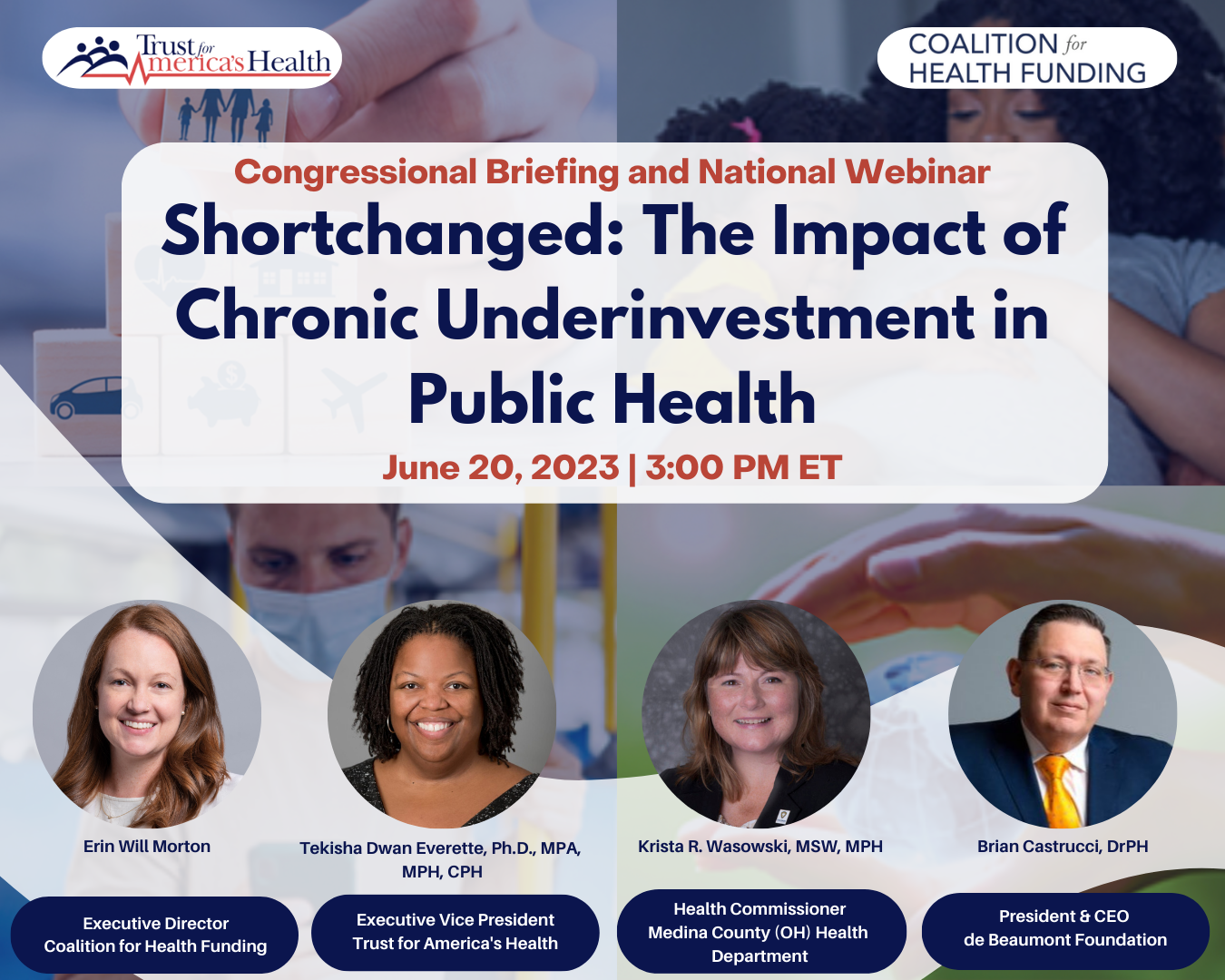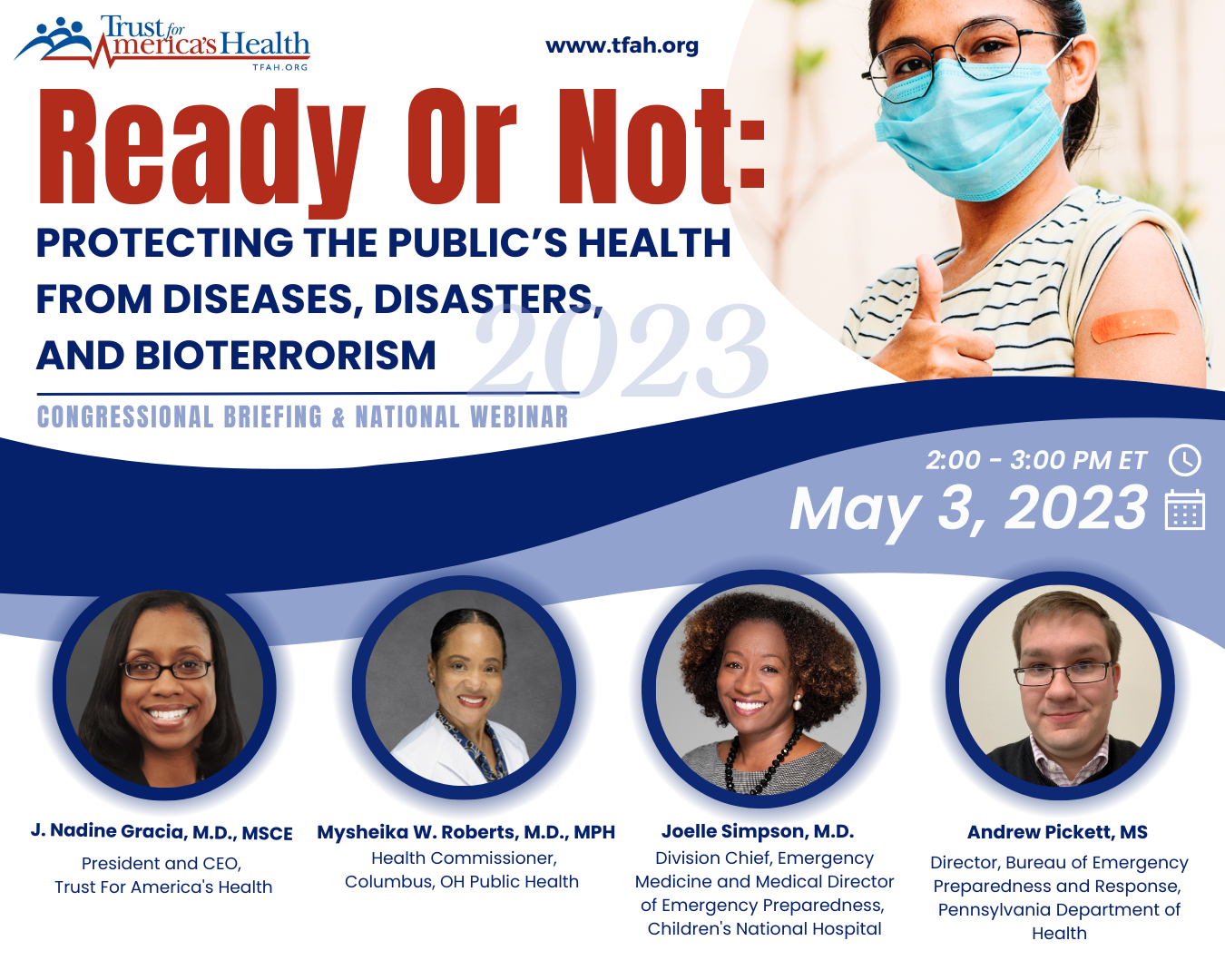Issue Category: Public Health Funding
Over 110 Organizations Call on Senate to Oppose Cuts to Prevention Fund
(Washington, DC – September 20, 2023) – Trust for America’s Health, American Public Health Association, Association of Public Health Laboratories, Big Cities Health Coalition, Campaign for Tobacco-free Kids, Council of State and Territorial Epidemiologists, National Association of County and City Health Officials, and more than 100 other organizations representing public health, healthcare, research, social services, and other sectors, today released a letter to the Senate Health, Education, Labor, and Pensions (HELP) Committee opposing a committee proposal to cut $980 million from the Prevention & Public Health Fund (“the Prevention Fund”) to pay for other health legislation.
The Prevention Fund is a critical source of funding for the Centers for Disease Control and Prevention and other agencies across Health and Human Services. The Prevention Fund invests in states and communities across the nation to strengthen systems and the workforce that allow us to provide immunizations, detect and control outbreaks, and prevent illness and early deaths from tobacco and chronic diseases. It supports activities outside one’s doctor’s office – separate and distinct from individual health concerns and treatments.
In an already challenging budget environment, this would further endanger the health of Americans. These cuts would impact not only health programs, but also labor and education, as it will leave a significant gap in base appropriations for the Labor-HHS-Education spending bill that will need to be backfilled. This pay-for has far reaching consequences for all ofthe programs that fall under the spending bill’s purview.
The letter in part reads:
“The nation can no longer afford to underfund public health…. Despite spending more than any other high-income nation on treating disease, the U.S. has substantially worse health outcomes, with life expectancy declining in recent years. Now is the time to invest in public health and prevention…
Cuts to the Prevention Fund will translate into funding shortfalls in programs that states have long relied upon to keep their residents healthy and safe. In its first 14 years (FY2010–23), the Prevention Fund has invested more than $12.3 billion in resources to states, localities, and tribal and community organizations in support of critical prevention and public health programs. These investments include the 317 immunization program that enables prevention of outbreaks, epidemiologists and public health laboratory grants in every state and territory to detect and investigate outbreaks and prevent further infections, the Preventive Health and Health Services (Prevent) Block Grant that enables states and localities to address their most pressing health concerns, supporting cancer screenings, and other critically important programs. Across the U.S. Department of Health and Human Services, the Prevention Fund supports programs such as suicide prevention, Alzheimer’s disease prevention, and chronic disease self-management.
Funding prevention not only saves lives, but it also saves money. The Prevention Fund’s Tips from Former Smokers Campaign alone saved an estimated $7.3 billion in smoking-related healthcare costs from 2012 to 2018 and helped more than one million Americans quit smoking for good. Public health funding has not kept up with the range of threats that public health must address. For many of these conditions, we know what works, but public health does not have the resources to address these growing health threats.”
The full text of the letter is linked here.
Information about the Prevention and Public Health Fund can be found here.
Organizations Joining the Letter:
ADAP Advocacy
American Academy of Pediatrics
American Association on Health and Disability
American College of Clinical Pharmacy
American College of Obstetricians and Gynecologists
American College of Physicians
American College of Preventive Medicine
American College of Sports Medicine
American Heart Association
American Lung Association
American Public Health Association
American Society for Microbiology
American Society on Aging
American Statistical Association
Association for Prevention Teaching and Research
Association for Professionals in Infection Control and Epidemiology
Association of American Medical Colleges
Association of Immunization Managers
Association of Maternal & Child Health Programs
Association of Pathology Chairs
Association of Public Health Laboratories
Association of Schools and Programs of Public Health
Association of State and Territorial Health Officials
Asthma and Allergy Foundation of America
Big Cities Health Coalition
CAEAR Coalition
Campaign for Tobacco-Free Kids
Center for Advocacy for the Rights and Interests of Elders (CARIE)
Children’s Environmental Health Network
Christian Council of Delmarva
City-County Health District
Colorado Public Health Association
Community Access National Network
Connecticut Public Health Association
Cook County Department of Public Health
Council of State and Territorial Epidemiologists
Dorchester County Health Department
Early Impact Virginia
Endocrine Society
Eta Sigma Gamma
Foundation for Healthy Generations
Futures Without Violence
GLMA: Health Professionals Advancing LGBTQ+ Equality
GO2 for Lung Cancer
Green & Healthy Homes Initiative, Inc
Health Promotion Consultants
Healthy Weight Partnership Inc.
HIV Medicine Association
HLN Consulting, LLC
Illinois Society for the Prevention of Blindness
Immunize.org
Institute for Public Health Innovation
International WELL Building Institute
Johns Hopkins Center for Health Security
Kansas Breastfeeding Coalition
Kentucky Voices for Health
Kids and Car Safety
Lakeshore Foundation
Linn County Public Health
Maine Public Health Association
March of Dimes
Marked By Covid
MaryCatherine Jones Consulting, LLC
Mel Leaman Free Clinic
Mental Health America
Minnesota Public Health Association
NASTAD
National Alliance of Public Health Students and Alums
National Association of Chronic Disease Directors
National Association of County and City Health Officials
National Association of Social Workers
National Center for Healthy Housing
National Center on Domestic and Sexual Violence
National Network of Public Health Institutes
National Nurse-Led Care Consortium
National Prevention Science Coalition
Nemours Children’s Health
New Jersey Public Health Association
New York State Public Health Association
Oregon Coalition of Local Health Officials
Peggy Lillis Foundation
Pennsylvania Public Health Association
Population Association of America
Prevent Blindness
Prevent Blindness Georgia
Prevent Blindness Ohio
Prevent Blindness Wisconsin
Prevent Child Abuse America
Prevention Institute
Public Health Foundation
Public Health Institute
Redstone Global Center for Prevention and Wellness
Resolve to Save Lives
RiverStone Health
Safe States Alliance
Society for Healthcare Epidemiology of America
Society for Maternal-Fetal Medicine
Society for Public Health Education
Society for Women’s Health Research
Sound Generations
Sound Generations – Project Enhance
Spina Bifida Association
Task Force for Global Health
The 317 Coalition
The Foundation for Sustainable Communities
The Gerontological Society of America
Trust for America’s Health
USAging
Vaccinate Your Family
Voices for Vaccines
Washington State Association of Local Public Health Officials
Washington State Public Health Association
Well-Being and Equity in the World
Wisconsin Public Health Association
YMCA of the USA
Letter from 110+ organization to Senate HELP Committee opposing Prevention Fund cuts (September 2023)
At One Year Mark Data Show 988 Suicide and Crisis Lifeline Has Improved Crisis Care Access and Response, and that Sustained and Increased Funding is Needed
This month marks the one-year anniversary of the 988 Suicide and Crisis Lifeline, which replaced the previous National Suicide Prevention Lifeline with a single three-digit number for mental health, substance misuse, and crisis services. With oversight and funding from the Substance Abuse and Mental Health Services Administration (SAMHSA) and assistance from partners like Crisis Text Line and The Trevor Project, 988 consists of independently operated and funded call and text/chat centers across the country. When individuals in crisis contact 988, trained crisis counselors at these centers listen, provide support, and share resources if necessary. Access to 988 can play a critical role in improving depressed, suicidal, or overwhelming feelings—in fact, SAMHSA estimates that 98% of individuals contacting 988 receive the crisis support they need in the moment. SAMHSA has also identified the current 988 system as a first step toward evolving crisis care to include mobile crisis units, which provide in-person responses, and stabilization centers, which provide a safe place to stay for individuals in crisis.
Even its current form, however, 988 represents a momentous advancement in the effort to connect more Americans with crisis services. In May 2023, for example, 988 answered 45% more calls, 52% more chats, and 938% texts compared to the previous lifeline in May 2022. In total, 988 answered nearly 160,000 more contacts in May 2023 compared to May 2022, and the average time to answer these contacts decreased from 140 seconds to 35 seconds. 988 has also launched specialized services for the LGBTQ+ population, and SAMHSA just announced the addition Spanish language text and chat services. Other specialized services will likely follow for hearing impaired individuals and American Indian/Alaska Native people.
In 2022, Congress supplemented the establishment of 988 with several pieces of legislation containing significant investments and policies to advance behavioral health. The Bipartisan Safer Communities Act (BSCA), passed in June 2022, for example, provided onetime support for 988 and increased support for the National Child Traumatic Stress Network. The BSCA also provided funding for Project AWARE at SAMHSA, which empowers education agencies through training for school personnel, increases awareness and detection of mental health issues, and connects youth and families to needed services. In addition, Congress directed the Centers for Medicare and Medicaid Services to assist schools with expanding school-based health services through Medicaid and funded initiatives at the U.S. Department of Education to hire and retain mental health professionals providing these services.
In the Consolidated Appropriations Act (CAA), enacted in December 2022, Congress built on these accomplishments by reauthorizing the Garrett Lee Smith Suicide Prevention Program, which funds mental health programs for college-age students, as well as several programs to improve the behavioral health workforce. The CAA also bolstered crisis-intervention programs by directing guidance and funding to providers and improving payment for their services.
The U.S. Department of Health and Human Services (HHS) also acted throughout 2022 to expand access to community-based mental health services. In partnership with the Department of Education, for example, HHS has worked to facilitate the use of Medicaid and Children’s Health Insurance Program funds to support school-based behavioral health services. SAMHSA also launched the Mental Health Crisis Response Partnership Pilot Program to improve access to mobile crisis services in high-need areas.
988 is part of a series of investments to address Americans’ mental health needs
Despite this progress, significant challenges remain in the effort to strengthen 988 and connect individuals in crisis to behavioral health services. For example, although state governments carry the responsibility for funding and operating 988 call centers, only a handful of states have passed legislation to secure long-term financial support for the lifeline through telecommunications fees. A recent study, moreover, found that only around half of states have earmarked sufficient funding to meet increased 988 center costs. Due in part to insufficient funding, call centers can also struggle to hire and retain qualified staff and answer rates can vary significantly by state. Improved data collection and analysis concerning 988 services is also necessary to help identify gaps in crisis care and improve lifeline implementation.
On the federal level, ongoing negotiations in Congress could result in cuts to appropriations for 988, which is an alarming prospect given that SAMHSA estimates outreach to the lifeline will increase by up to 50%—to a total of around 9 million contacts—in FY 2024. States will also require additional federal support to develop and implement mobile responses and stabilization units and publicize the full range of 988 services. A recent survey by the Pew Charitable Trusts, for example, found that only 13% of U.S. adults knew about the existence and purpose of 988; awareness was higher among white adults and individuals with a college education compared to Black adults and individuals with a high school degree or less.
Trust for America’s Health (TFAH) will continue to advocate for additional funding and resources to bolster the 988 lifeline and transform the behavioral health crisis system more broadly. Continued bipartisan support is necessary not only to ensure access to existing services, but also to build the next generation of care to meet the growing demand from Americans in crisis.
Recommendations for addressing Americans’ mental health needs and other issues are available in TFAH’s 2023 Pain in the Nation report.
New Report: Under-Investment in Public Health Leaves Nation Less Prepared for Current and Future Health Risks
COVID-19 Emergency Funding Helped Control the Pandemic, but Did Not Address Structural Weaknesses in the Nation’s Public Health System
(Washington, DC – June 14, 2023) – Decades of underfunding have left the nation’s public health system ill-equipped to protect the health of Americans, according to a new report, The Impact of Chronic Underfunding on America’s Public Health System: Trends, Risks, and Recommendations, 2023, being released today by Trust for America’s Health.
Insufficient funding for public health programs has been a long-standing problem. The COVID-19 crisis illuminated weaknesses in the nation’s public health infrastructure, including antiquated data systems, insufficient public health laboratory capacity, an under-resourced public health workforce, and the need for improved public health communications. These foundational public health capacities require increased, flexible, and sustained funding.
While pandemic response emergency funding was critical for addressing the crisis, it represented one-time funding and was often limited to COVID-19-specific spending, i.e., it could not be spent on underlying infrastructure needs. Furthermore, in most instances, this funding has now ended or was rescinded in the recent debt limit agreement. The nation is therefore at risk of returning to a boom-and-bust pattern of sporadic funding increases for public health during emergencies followed by insufficient funding in non-emergency periods.
The U.S. Centers for Disease Control and Prevention (CDC), the primary source of public health funding for state, local, tribal, and territorial health departments, is itself reliant on the annual federal appropriations process. Over the past two decades (FY 2014 – 2023), the CDC’s budget has increased by just 6 percent after adjusting for inflation, leading to insufficient funding in key program areas such as emergency preparedness and chronic disease prevention.
Two CDC programs focused on public health preparedness and response, the Public Health Emergency Preparedness Program (PHEP) and the Healthcare Readiness and Recovery Program, have both experienced major budget cuts over the past two decades. After adjusting for inflation, PHEP funding has been reduced by about half since 2003, and the budget for the Healthcare Readiness and Recovery Program has decreased by nearly two-thirds during the same period.
In addition to the risks associated with health emergencies, the country faces a growing number of people living with chronic diseases and the associated healthcare costs. Today, roughly 60 percent of the U.S. adult population has at least one chronic disease, such as obesity, diabetes, or heart disease. Treating these chronic diseases, along with mental health conditions, accounts for the vast majority of U.S. healthcare spending. While evidence-based public health programs that help prevent chronic disease are doing important work, insufficient funding has limited their accessibility and impact in many communities.
“We must address the serious mismatch between the nation’s public health needs and its public health investment,” said J. Nadine Gracia, M.D. MSCE, President and CEO of Trust for America’s Health. “Public health and prevention represent only a small fraction of the more than $4 trillion in annual health spending in our nation. Increased and sustained investment in public health would not only better prepare us for future public health emergencies, it would also help address the root causes of poor health and health disparities.”
TFAH is calling for annual funding for CDC of at least $11.581 billion in FY 2024, the level requested in the President’s FY 24 budget (FY 2023 CDC funding is $9.2 billion).
Other policy recommendations within the report include:
- Increase and sustain disease-agnostic funding to strengthen public health infrastructure. Public health experts estimate an annual shortfall of $4.5 billion in necessary funding for state and local health departments to provide comprehensive public health services in their communities.
- Strengthen public health emergency preparedness, including within the healthcare system. Investments should include the restoration of funding to the Public Health Emergency Preparedness Cooperative Agreement, the Healthcare Readiness and Recovery Program, and programs designed to support vaccine infrastructure as well as prevent, detect, and contain antimicrobial-resistant infections.
- Modernize the public health data system to ensure comprehensive and real-time data sharing during public health emergencies. Public health experts estimate that at least $7.84 billion is needed over the next five years for CDC’s Data Modernization Initiative to strengthen public health data collection and reporting at the state and local levels. Congress should also provide sustained funding for CDC’s new Center for Forecasting and Outbreak Analytics.
- Bolster the recruitment and retention of the public health workforce. In 2021, it was estimated that state and local public health departments needed to hire an additional 80,000 employees to be able to deliver a minimum set of public health services. The one-time nature of short-term emergency funding means that health departments will continue to experience understaffing.
- Address health disparities and the root causes of disease by addressing the social determinants of health and investing in chronic disease prevention.
- Invest in programs to prepare for and mitigate the impacts of climate change.
Read the full report
The Impact of Chronic Underfunding on America’s Public Health System: Trends, Risks, and Recommendations, 2023
Shortchanged: The Impact of Chronic Underinvestment in Public Health
Policymakers are asking: With the United States spending far more on healthcare compared to other high-income nations, why does our nation still yield substantially worse health outcomes and what funding and policy actions must we take to see better results?
To shed light on that important question, Trust for America’s Health (TFAH) and the Coalition for Health Funding (CHF) are gathering experts in public health policy and funding on June 20th to discuss the critical need for increased, sustainable, and flexible funding that specifically targets public health and prevention. The discussion will focus on how to address the longstanding gaps in public health capacity resulting from chronic underfunding.
Resources:
- Chronic Underfunding of the Public Health System Fact Sheets
- Health Action Alliance
- The Impact of Chronic Underfunding on America’s Public Health System: Trends, Risks, and Recommendations, 2023
- Public Health Communications Collaborative
- Public Health Reaching Across Sectors
- Public Health Workforce Interests and Needs
Written Statement of Dr. J. Nadine Gracia to Senate LHHS Subcommittee on FY24 Appropriations (May 2023)
Ready or Not 2023: Protecting the Public’s Health from Diseases, Disasters, and Bioterrorism
This briefing explores the findings from TFAH’s recent report, Ready or Not 2023: Protecting the Public’s Health from Diseases, Disasters, and Bioterrorism.
The past year alone saw the U.S. surpassing 1 million deaths due to COVID-19, decreasing rates of routine vaccinations, and increasing prevalence of health misinformation. In addition, last year the U.S. experienced 10 or more billion-dollar weather-related disasters for the eighth consecutive year. The webinar will review TFAH’s 2023 Ready or Not report which measures states’ degree of preparedness to respond to a wide spectrum of health emergencies and to provide ongoing public health services.
Subject matter experts discussed the nation’s readiness for public health emergencies, examine the findings of the report, and discuss key recommendations for policymakers.
Resources:
Trust for America’s Health
- Ready or Not 2023: Protecting the Public’s Health from Diseases, Disasters, and Bioterrorism
- Ready or Not 2023 – State-by-State Fact Sheets
Children’s National Hospital



